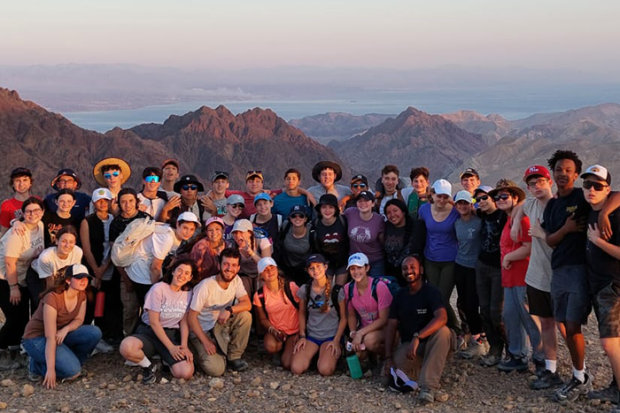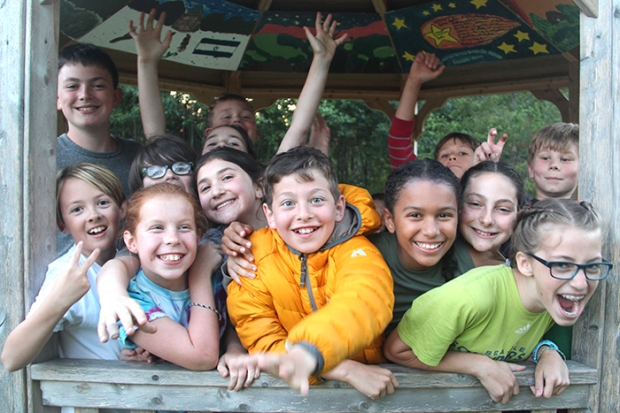Sukkot commemorates the time when the Jewish people wandered in the desert and lived in temporary shelters. It's a harvest festival, and during this weeklong celebration we spend time outdoors in a sukkah, a makeshift structure covered with branches to look just like the huts our ancestors used. It's also a chance to move beyond the material comforts of home to connect with family and nature.
Together with your children, watch the videos below, "Noam’s Sukkot" and “Kids Talk About Sukkot” by Shalom Sesame. Then try some of the discussion ideas and activities suggested by Reform Jewish educators to further extend the lessons learned in the videos. If you wish, share your experiences and ideas in the comments sections below!
Discussions
Appreciating what we have
The holiday of Sukkot lasts for eight days, during which we try to spend as much time as we can outdoors. This means giving up some of the comforts of home - air conditioning, clean floors, and comfy couches. Ask your kids what surprised them during their time spent outside - any new realizations about nature? What did they learn to appreciate?
Creating a special space
It is also customary to recite blessings over ritual objects: the yellow lemon-like etrog and a collection of three special branches called the lulav. It is traditional to unite these "four species" and shake them in all directions, symbolizing the creation of a special space. Ask your children what makes your home in the sukkah different from your usual home. What makes the sukkah special? Why is it important to set aside time and dedicate it to building and living in a sukkah?
Pitching in
In this video, Israeli children talk about how they help their families when it's time to build a sukkah. Building a new house can seem like a daunting task, but when everyone pitches in, the workload lightens up and the process is more fun. Help your child identify his strengths. Is he artistic? Good at building? How can he use these talents to help with the sukkah project? Also ask him to think about the strengths of other family members (mom, dad, and siblings). Everyone can play an important part during Sukkot!
Learning from Mother Nature
Sukkot is a time when we - quite literally - immerse ourselves in nature. Choosing to socialize, eat, and even sleep outside makes us not only appreciate the homes we have, but also the natural beauty that surrounds us. Ask your kids about their favorite part of nature, and why they appreciate it. Why is it important to spend so much time outside, especially during Sukkot? How can we incorporate nature into our daily lives?
Activities
Setting up your sukkah
A sukkah can come in any shape or size. Even if you don't have access to a sukkah, it's easy to get creative with some temporary dwellings. Set up a fort in the backyard and camp out with the kids for a night. Or, if you're a city-dweller with limited outdoor space, there are more practical options (what kid doesn't love to build a pillow fort?).
Taking your own nature trek
Take a walk together through nature, away from the hustle-and-bustle of everyday life. Try collecting different pieces of nature on your stroll - twigs, colorful leaves, dandelions, and even dirt! You can use these pieces of nature to create art and decorate your sukkah with them. When you look on the walls of your sukkah, you will all remember the nature trek. After all, the best pieces of art are ones that represent shared memories.
Food, glorious food!
We may not think too much about harvesting in modern times, but it used to be a really important season for our ancestors. Talk with your kids about how people used to grow their own food and plow their own fields. The whole cycle of seasons required a lot of hard work, patience, and appreciation. Now is a good time to talk about where your food comes from. Liven up the lesson by going apple- or pumpkin-picking.
Imagine You Were There
Imagine that you and your group are about to go on a journey through the desert. How will you travel, and who will come with you? What will it be like to sleep in a small hut and look up at the stars? Write down what you and your students imagine you might discover on this adventure, and draw pictures of your temporary home in the desert.
From the tree to the market
Noam's family has an etrog farm. Watch the video together and discuss what happens to the etrog from the first time you see it on the tree. You can ask the children to draw the etrog on its journey from the tree to the market, cut up the pictures that represent each step and create a sequencing card game. This is one of the ways children can learn that things we often take for granted are the result of a process and the efforts of many individuals.
Mitzvah recycling
In some Jewish communities an item that was used to perform one mitzvah, like the etrog, is recycled to be used for another mitzvah. Together, insert cloves into the etrog and then let it dry for a few weeks. Show members of your group how they helped transform the etrog into a fragrant spice that can be used for the havdalah ceremony at the end of Shabbat.
Read together
Night Lights: A Sukkot Story - On a dark night full of many mysterious sounds, Daniel and his older sister Naomi set out to sleep in their family sukkah. Because there is no outlet to plug in a night light, Daniel and Naomi come to see the stars above as the same night lights the ancient Israelites used on their journey in the desert.
Shalom Sesame: "Noam’s Sukkot"
Shalom Sesame: "Kids Talk About Sukkot"
More videos from Shalom Sesame:
For more Shalom Sesame videos, activities, and other materials, visit our friends at Shalomsesame.org.


